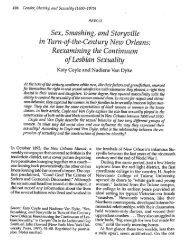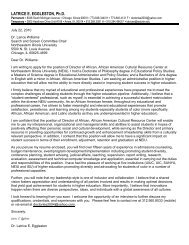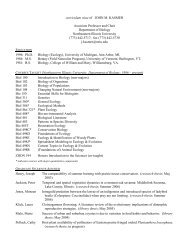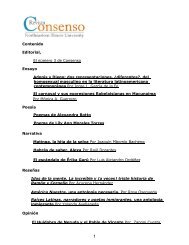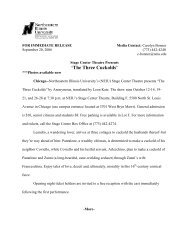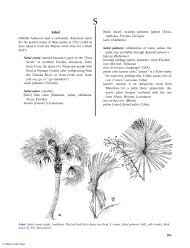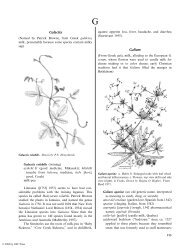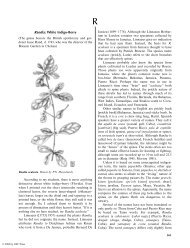Herba Cana - Northeastern Illinois University
Herba Cana - Northeastern Illinois University
Herba Cana - Northeastern Illinois University
Create successful ePaper yourself
Turn your PDF publications into a flip-book with our unique Google optimized e-Paper software.
© 2004 by CRC Press<br />
The Ethnobotany 497<br />
‘‘insanity,’’ any kind of confusion or odd behavior<br />
(Sturtevant 1955). Still another use is during childbirth.<br />
Gupta (1995a) reported that an ethanolic extact of<br />
cabbage palm fern showed activity against certain<br />
viruses. It has not been confirmed that the species has<br />
the same activity as others called calaguala.<br />
Phoradendron<br />
(Thomas Nuttall named this with Greek phoros,<br />
bearing, dendron, tree)<br />
Phoradendron leucosperma. From Britton and Brown 1896.<br />
Viscum album (although European mistletoe is<br />
placed in a genus distinct from the American<br />
plants, they differ in technical details; people<br />
familiar with the plants in Europe would have<br />
had no trouble recognizing the eastern North<br />
American species)<br />
druidh lus (druidh, Druid, lus, herb, Gaelic); gui<br />
(French); guis (sticky, Irish)<br />
mistletoe (a word from Old English in use by A.D.<br />
1100; from mistle, dung, and tan, twig; akin to<br />
Old High German mistil, mistletoe, and zein,<br />
twig; the name came into existence because<br />
people believed that the mistle thrush, Turdus<br />
viscivorous, excreted the seeds on limbs; it<br />
actually scrapes them off its bill; see Austin<br />
1998a); Mistel (German); misteltein (Norwegian);<br />
oak mistletoe (USA)<br />
muérdango (Spanish)<br />
uil’-ioc (all-heal, Gaelic)<br />
vischio (from Latin viscos, sticky, Italian); visco<br />
(Portuguese)<br />
Vogel-liem [Vogellym] (birdlime; cf. Turner [1548]<br />
1965)<br />
Phoradendron leucocarpum (white-fruited) ( /P.<br />
flavescens, misapplied)<br />
a:tilhiciksó imitto (a:tilhiciksó, elf, im, his, ittó,tree,<br />
Koasati)<br />
antcka’ nûta’wayi’ (Biloxi)<br />
fani shapha (fani, squirrel, shapha, flag, Choctaw);<br />
fanishapha’ (fani’, squirrel, im, its, shapha’, flag,<br />
Chickasaw); ipɬ iäsapha (squirrel’s flag, from<br />
ipɬ o, squirrel, im /sapha, its flag, Alabama)<br />
fani’ hasimbish (fani’, squirrel, hasimbish, tail,<br />
probably is this plant, Chickasaw)<br />
gui (mistletoe in French, Houma, Louisiana)<br />
hinɬ ímásókcî [hinrímásókcî, henle ’mashokche]<br />
(squirrel tea, Mikasuki)<br />
’to eleko [ito-iliko, toiliko, tuhiligu, eto-eleko, tóhelleko,<br />
tohiríkko, tohiɬ ikko, toheleko] (eto, tree,<br />
eleko, feet, Creek, Muskogee)<br />
uda’li (it is married, Cherokee)<br />
Mistletoe has a long association with native people<br />
throughout the eastern United States, much as it has<br />
among the Europeans. The Cherokee, for example,<br />
used it to treat headache, epilepsy, in ‘‘medicine for<br />
pregnant women,’’ to lower high blood pressure, and<br />
to cure vomiting (Hamel and Chiltoskey 1975).<br />
Among the Muskogean people, the Chickasaw made<br />
a remedy from it to treat ‘‘Red Squirrel Sickness’’<br />
(toothache, swollen jaw, and sometimes nosebleed)<br />
(Swanton 1928a,b). The Houma made a decoction of<br />
the plant to aid debility and paralytic weakness,<br />
considering it something of a panacea (Speck 1941).<br />
The Yuchi use it to treat ‘‘Raccoon Sickness’’ (diarrhea,<br />
usually in babies) (Howard 1984). The Creeks<br />
made medicine from leaves and branches for lung<br />
troubles, including consumption (Swanton 1928a).<br />
The Florida Seminoles use it to treat ‘‘Deer Sickness’’<br />
(numbness, painful limbs and joints), as an emetic<br />
during ceremonies, and as a medicine for chronically<br />
ill babies (Sturtevant 1955). The Oklahoma Seminoles<br />
make an infusion of leaves and berries for ringworm<br />
sores and to treat hemorrhoids, and give it to children<br />
for whooping cough (Howard 1984). Modern Florida<br />
Seminoles include it as part of the ‘‘Death Medicine’’<br />
(Snow and Stans 2001).<br />
Phragmites<br />
(From Greek phragma, hedge, fence, or screen,<br />
plus /ites, resembling; the word was used by Pliny,<br />
A.D. 23 /79, for a reed)<br />
Phragmites australis (southern)<br />
abo’djigun (something turned out or over, Ojibwa)<br />
act (Atakapa)





